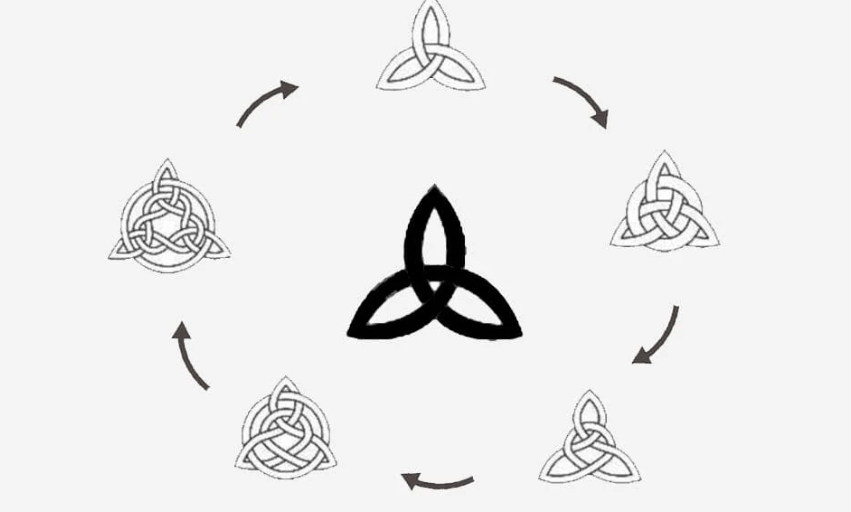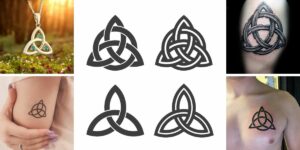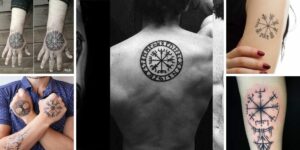The Trinity symbol, widely recognised as the Triquetra or Trinity Knot, is a timeless emblem steeped in cultural and spiritual significance. This intricate design, with its three interlocking loops, has captivated hearts across centuries, from ancient Celtic traditions to modern-day jewellery. Often seen adorning a Trinity Knot necklace or Trinity Knot pendant, this symbol transcends mere aesthetics, embodying profound meanings of unity, eternity, and spirituality. Whether you’re drawn to its Celtic roots or its Christian associations, the Trinity Knot carries a universal appeal that resonates with diverse audiences. In this article, we’ll explore its origins, meanings, and modern-day relevance, offering insight into why this iconic design remains a beloved choice in jewellery and beyond.
The Origins & History of the Trinity Symbol
The Trinity symbol, or Triquetra, boasts ancient origins that trace back to pre-Christian Celtic culture. Emerging around the 7th century, this symbol was initially associated with pagan beliefs, representing the interconnectedness of natural elements such as earth, sea, and sky. Its continuous, interwoven design reflected the cyclical nature of life, a core tenet of Celtic spirituality.
With the spread of Christianity in Ireland, the Triquetra was embraced by early Christians to symbolise the Holy Trinity—Father, Son, and Holy Spirit. This adaptation is evident in iconic medieval manuscripts like the Book of Kells, where the Celtic Knot Holy Trinity appears in elaborate illuminations. Archaeological findings, such as stone carvings and metalwork from the Insular period, further showcase the symbol’s prominence. The seamless blending of Celtic and Christian iconography highlights the Trinity Knot’s versatility, cementing its place as a bridge between ancient and sacred traditions.
The Meaning Behind the Trinity Knot
The Trinity Knot meaning varies across cultures, yet its essence remains rooted in unity and interconnectedness. In Celtic tradition, the Triquetra symbolises the harmony of three essential elements—often interpreted as earth, sea, and sky or life, death, and rebirth. This reflects the Celtic worldview of balance and cyclical existence, where all aspects of life are intertwined.
For Christians, the Celtic Triquetra Trinity Knot meaning centres on the Holy Trinity, representing the unity of Father, Son, and Holy Spirit. This interpretation imbues the symbol with divine significance, making it a powerful emblem in religious contexts. In modern times, the Trinity Knot has evolved to embody universal themes of love, eternity, and unity, often exchanged during weddings or spiritual ceremonies. Its enduring appeal lies in its ability to convey profound personal and cultural meanings, resonating with those who value heritage and spirituality.
The Trinity Symbol in Jewellery & Fashion
The Trinity symbol shines brightly in the world of jewellery, particularly in the form of the Celtic Trinity Knot necklace and Trinity Knot pendant. These pieces are cherished for their elegant design and deep symbolism, making them popular gifts for occasions like anniversaries, weddings, or christenings. Crafted from materials such as sterling silver, gold, or even adorned with gemstones, these items blend timeless beauty with cultural significance.
People wear Trinity Knot jewellery to express their faith, honour their Celtic heritage, or celebrate personal milestones. For some, a Trinity Knot necklace serves as a reminder of love and connection, while for others, it represents spiritual devotion. The versatility of the design allows it to complement both traditional and contemporary styles, ensuring its place in modern fashion. Jewellers like Solvar and Claddagh Rings continue to innovate, offering intricate variations that keep the Trinity Knot relevant in today’s jewellery market.
The Triquetra vs. Other Celtic Knots (Continued)
The Triquetra, often referred to as the Trinity Sign, stands out for its elegant simplicity compared to other Celtic knots. For instance, the Shield Knot, often used for protection, features a more angular and enclosed design, while the Triquetra’s flowing loops evoke movement and interconnectedness. This distinction makes the Trinity Knot particularly suited for jewellery, such as the Celtic Trinity Knot necklace, where its graceful form complements both minimalist and ornate styles. Unlike the Spiral Knot, which represents growth and evolution, the Triquetra encapsulates a sense of eternal unity, making it a versatile symbol for both spiritual and secular expressions. By understanding these differences, one can better appreciate the Triquetra’s unique place in Celtic art and its enduring appeal in modern contexts.

Modern Uses & Pop Culture References
The Trinity symbol has transcended its ancient origins to become a prominent feature in contemporary culture. Its striking design has made it a favourite in popular media, most notably in the television series Charmed, where the Triquetra served as a symbol of sisterhood and magical power. This exposure introduced the Trinity Knot to a global audience, sparking renewed interest in its history and meaning. Beyond television, the Celtic Triquetra Trinity Knot meaning has inspired its use in tattoos, where individuals incorporate it to signify personal beliefs, family bonds, or spiritual journeys.
In addition, the Trinity Knot appears in logos, artwork, and even corporate branding, symbolising unity and eternity. Its presence in modern spirituality is equally significant, with many adopting the Trinity Sign in meditation practices or as a talisman for balance and harmony. This widespread adoption underscores the symbol’s ability to resonate across diverse contexts, from pop culture to personal expression.
The Enduring Appeal of the Trinity Knot
The Trinity Knot’s versatility is one of its greatest strengths. Whether worn as a Trinity Knot pendant or etched into a stone carving, its design speaks to universal themes that transcend time and culture. In Celtic tradition, it captures the interconnectedness of life’s elements, while in Christianity, it embodies the divine unity of the Holy Trinity. Its modern interpretations—love, eternity, and unity—further broaden its appeal, making it a meaningful choice for those seeking to express their values or heritage.
The Trinity Knot necklace has become particularly popular among those with Irish or Celtic ancestry, serving as a tangible link to their cultural roots. Jewellers like My Irish Jeweler and Claddagh Rings note that customers often choose these pieces for their emotional resonance, whether as gifts for loved ones or as personal keepsakes. The symbol’s adaptability ensures it remains relevant, whether in a religious setting, a wedding ceremony, or a casual fashion statement.
How to Choose a Trinity Knot Jewellery Piece
When selecting a Celtic Trinity Knot necklace or Trinity Knot pendant, consider the materials and craftsmanship. Sterling silver is a popular choice for its durability and affordability, while gold offers a luxurious touch for special occasions. Some designs incorporate gemstones like emeralds or diamonds, adding a modern flair to the traditional symbol. It’s also worth exploring the craftsmanship behind the piece—handmade items from reputable jewellers often carry a story of their own, enhancing the Trinity Knot’s cultural significance.
Buyers should also reflect on the meaning they wish to convey. A Trinity Knot necklace might be chosen to honour a spiritual belief, celebrate a milestone, or simply embrace Celtic heritage. Whatever the reason, the symbol’s timeless design ensures it will remain a cherished accessory for years to come.
Conclusion
The Trinity symbol, with its rich history and multifaceted meanings, continues to captivate and inspire. From its ancient Celtic origins to its adoption as a Christian emblem of the Holy Trinity, the Triquetra embodies a profound sense of unity and eternity. Its presence in jewellery, such as the Celtic Trinity Knot necklace and Trinity Knot pendant, allows individuals to carry its legacy with them, whether as a symbol of faith, love, or heritage. In modern culture, its appearances in media and personal expressions like tattoos highlight its enduring relevance. Whether you’re drawn to its spiritual depth or its aesthetic beauty, the Trinity Knot invites exploration. Consider embracing its charm through a piece of jewellery or artwork, and let this ancient symbol weave its timeless magic into your life.




